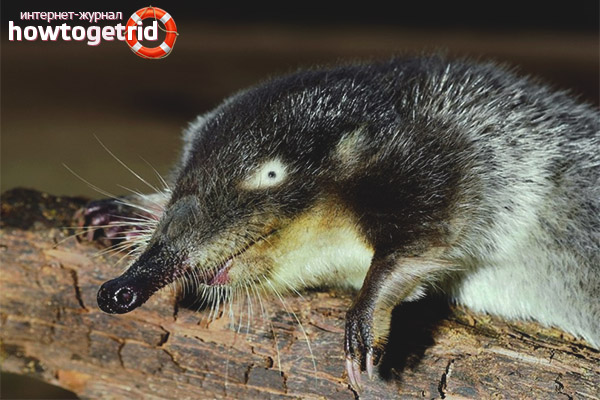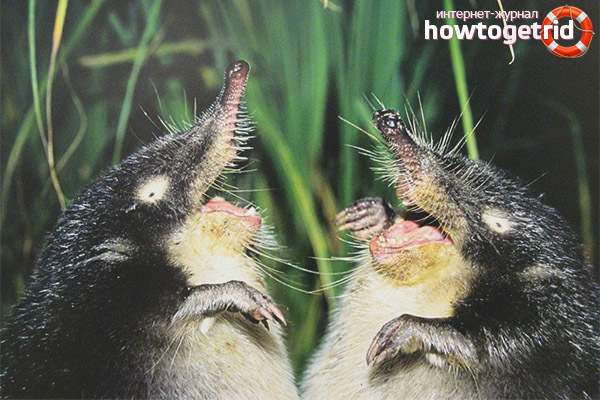The content of the article
In the vastness of our homeland there is a rather interesting beast called the desman. It is listed in the Red Book, and therefore protected by law. It is assigned to mammals and an insectivorous detachment. There are quite a lot of similar varieties, but the animal presented differs from self-similar habits and external data. Today we will analyze everything that is connected with it, so that everyone can make their own opinion.
Habitat and Description
- The species of mammals under discussion is widespread in Russia. People like to live in weakly flowing water sources that are shallow. They go ashore, found in a forest strip. Distribution mainly affects the Dnieper, Don, Urals, Volga. All rivers have the necessary characteristics for a full stay. In large sources, individuals are practically not common.
- As for external data, animals have an elongated muzzle, paws with five fingers, membranes and sharp claws, as well as an elongated mustache. The tail is powerful and flattened. External features literally scream that this animal belongs to the semi-aquatic inhabitants. The case is oval in format, the ears are small, the eyes are also small. The coat does not let water through due to the presence of special grease.
- Due to the membranes present on the paws, the animal quickly moves in the aquatic environment. Claws are aimed at facilitating tearing of the soil. In the ears there are special membranes that protect against moisture. According to their overall characteristics, individuals are stretched to half a meter, no more. Approximately 23 cm. Tail section. By weight, individuals are about 500 g.
- The fur cover is famous for its interesting structure. The animals have an undercoat, which is impregnated near the skin with an oily lubricant. It does not allow hypothermia and protects against getting wet. The outer hair is tough and durable. Pigmentation is quite different, ranging from gray with a silver tint to brown (almost black).
- As with all semi-aquatic individuals, these mammals differ in the tail part. This is their pride. The tail is flattened, powerful, compressed from the sides. It is necessary not only as a rudder during movement in the aquatic environment, but also to maintain heat in the cold season. On the tail there are keratinized particles, in the upper section there is hard hair. Smelly glands are present at the very beginning of the tail.
- The limbs located behind are also powerful. They provide speed, participate in swimming and enhance the effect of the tail. The front legs of a shortened format are practically not used during movements in the aquatic environment. The muzzle is long in format, the nose is mobile. While under water, the animal can be without air for a long time.
- A distinctive characteristic of mammals of the present order is their ability to search for food and absorb it directly at the bottom of a water source. This becomes possible due to the presence of a special valve in the nose and a special structure of the oral cavity. The vision of a muskrat is poor, however, this drawback is compensated by the excellent sense of touch and smell.
Lifestyle
- These animals are distinguished by their hard work. Despite the fact that they spend most of their existence in the aquatic environment, they can also live on land. Burrows are built over a long time. There is a main "room" for sleep, as well as nutrition and the creation of offspring. All moves are marked, and the tunnels are separated by cameras.The animal is organized and practical.
- These representatives of the family have a single way of being. However, they can gather in small groups to feel safe in the winter. Moreover, individuals of all ages and gender live nearby. Housing is lined with grass, foliage, other knots and even a feather.
- Now it makes sense to touch on the diet. Individuals can not boast of outstanding overall characteristics, but they eat a lot. The food includes insects, which form the basis of the basic menu. Also used are insect larvae, mollusks, fry, leeches and crustaceans.
- In the springtime, these animals have a hard time. When the snow cover begins to melt, the shelter is often flooded. In order to survive, the family sets off on a journey and leaves a warmed place. In the summer season, on the contrary, the desman lacks water. Rivers become shallow, forcing them to flee the house.
Enemies
- It is noteworthy that the considered individuals rather slowly move on land. Because of this feature, animals in the wild have a lot of natural enemies. Often, foxes, ferrets, otters, kites, wild cats and dogs can be distinguished among them.
- Represented animals are often selected on land during the mating season. This period falls specifically in the spring flood. At this time, one can clearly hear various interesting sounds that females make to attract males. The latter, in turn, also beautifully chatter.
- Quite rarely, skirmishes arise between males for the female’s attention. Often, females can give birth twice a year. This occurs in spring and autumn. After mating, about 5 babies are born. At this time, the male is always next to the chosen one. Parents together guard and raise offspring.
Breeding
- As for the puberty of the animals under discussion, it occurs at the age of approximately 10 months. During the mating season, peculiar games begin. Males begin to fight with each other. Females, in turn, make gentle and beautiful sounds. In this way they show their willingness to mate.
- After mating, the female continues to bear offspring for about 1 month. Then completely helpless and blind babies are born, whose weight does not exceed 5 grams. As mentioned earlier, 2 to 5 cubs are born. Literally after 1 month, the offspring can fully eat adult food.
- After a few more months, the cubs are already beginning to lead a completely independent lifestyle. For a female, giving offspring twice a year is quite normal for a female. Peak fertility is most often observed in early summer and winter. In the wild, animals live no more than 4 years. In captivity, individuals live up to 5 years.
Population
- In the 19th century, people massively exterminated such animals. This was due to the value of animal skins and their musky fluid. The latter was actively used in the manufacture of perfumes. The secret of individuals allowed for a long time to fix the pleasant aroma of perfume.
- Because of this, the number of animals represented began to decline dramatically. In the modern world, it is definitely impossible to calculate the number of animals. The problem is that animals try to lead a very secretive lifestyle. On land, these individuals are extremely rare.
- It is worth noting that scientists were able to approximately calculate the number of such animals. Around the world there are about 30,000. This is not so small, but individuals are protected. At the moment, animals are slowly dying out due to environmental pollution.
- Along with this, reservoirs and rivers are drained. Forests are cut down and dams are built. All this negatively affects the animal world. In addition, the animals presented often suffer from fishing nets. To correct the situation, the animal was listed in the Red Book.At the same time, individuals received status - a rare relict species that is prone to extinction.
- Currently, there are 4 large reserves and about 80 reserves, in which individuals are under the supervision of specialists. People are trying to restore the number of animals. Also, individuals are under serious protection.
The animals presented are quite interesting and unique. Due to their size and characteristic features, they are almost defenseless. The animals have a lot of natural enemies. In addition, they suffer greatly from human activity.
Video: desman (Desmana moschata)












Submit